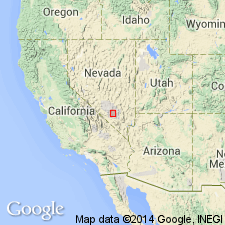
- Usage in publication:
-
- Stockade Wash member*
- Modifications:
-
- Named
- Dominant lithology:
-
- Tuff
- AAPG geologic province:
-
- Great Basin province
Summary:
Named as a member (1 of 8) of Oak Spring formation for Stockade Wash west of Yucca Flat in north-central part of the Nevada Test Site, Nye Co, NV in the Great Basin province. No type locality designated. In the section at Stockade Wash shown on a cross section, the member is overlain and underlain by Survey Butte member (new) of Oak Spring; member shown on section as tonguing out into Survey Butte between the butte and East Rainier Mesa. Consists of white, gray and brown nonwelded to partially welded tuff. Nonstratified orange to tan pumice fragments as much as half inch long found in most of the member. Local calcite cement. Base is zeolitic locally. Phenocrysts of quartz, feldspar, and biotite amount to less than 5 percent of tuff. Noted for contorted layers and closely spaced polygonal joints of fumarolic origin found west of Tippipah Spring. Forms cliffs, rounded knobs, low hills. Is 0-290 ft thick. Extends from western and southern Rainier Mesa west to Fortymile Canyon. Of Miocene? and younger age.
Source: GNU records (USGS DDS-6; Denver GNULEX).
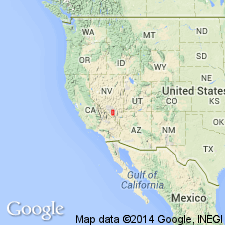
- Usage in publication:
-
- Stockade Wash Member*
- Modifications:
-
- Revised
- AAPG geologic province:
-
- Great Basin province
Summary:
Reassigned from being one of the members of Oak Spring Formation to member (1 of 5) of Piapi Canyon Formation (new), upper formation of Oak Spring Group (rank raised). Shown as a lenticular body enclosed by the Survey Butte Member, also newly assigned to Piapi Canyon on north part of cross south of Oak Spring Butte, north part of the Nevada Test Site, Nye Co, NV in the Great Basin province. Is a multiple-flow simple or compound cooling unit of rhyolitic welded and nonwelded ash-flow tuff and associated ash-fall tuff. Thought to have been derived from the Timber Mountain area to west. Of early Pliocene or younger age.
Source: GNU records (USGS DDS-6; Denver GNULEX).
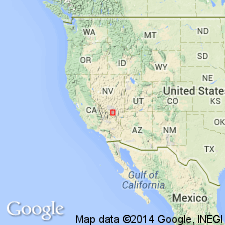
- Usage in publication:
-
- Stockade Wash Member*
- Modifications:
-
- Revised
- AAPG geologic province:
-
- Great Basin province
Summary:
Is one of five named members reassigned from Piapi Canyon Formation of Oak Spring Group to Paintbrush Tuff of Piapi Canyon Group. Oak Spring as a formation or as a group abandoned. Is overlain and underlain by unnamed bedded tuffs of Paintbrush Tuff. Is recognized in the north and west part and in Yucca Flat area, Nevada Test Site, Nye Co, NV in the Great Basin province. Nomenclature chart. Cross section. Paintbrush is assigned a Miocene? and Pliocene age.
Source: GNU records (USGS DDS-6; Denver GNULEX).
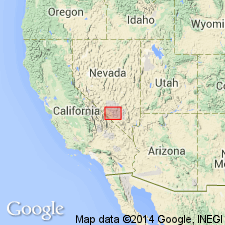
- Usage in publication:
-
- Stockade Wash Tuff*
- Modifications:
-
- Revised
- AAPG geologic province:
-
- Great Basin province
Summary:
Removed from Paintbrush Tuff as its lowest named member because it is lithologically and petrologically unlike ash-flow tuff units in the Paintbrush, has a different source--Silent Canyon caldera--than the Paintbrush-Claim Canyon cauldron, whereas it does have same source and is more closely related to the calc-alkalic tuffs and rhyolite lavas in Area 20. Isopach map. Present as one small body east of Pahute Mesa and a larger body that extends from Split Ridge south to Frenchman Flat mostly in Nye Co, but extends for a short distance into Lincoln Co, NV, Great Basin province. Ranges from 0 to 120+ m thick. Stratigraphic chart. Volume of the member probably between 20 and 40 cubic km depending on thickness and extent under Yucca Flat. Rests on and is overlain by bedded and ash-flow tuff of Area 20. Classified as a simple cooling unit of massive nonwelded to partly welded ash-flow tuff with 4-9 percent phenocrysts generally less than 1 mm. Has randomly oriented orange pumice fragments that average half an inch in yellow-gray to yellow-brown matrix. Characterized by abundant green-gray dense devitrified xenoliths of peralkaline rocks. Chemical analyses. Erupted between 13.8 and 13.2 m.y. ago.
Source: GNU records (USGS DDS-6; Denver GNULEX).
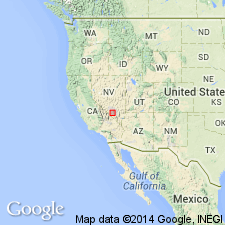
- Usage in publication:
-
- Stockade Wash Tuff
- Modifications:
-
- Not used
Summary:
Not used in southwest Nevada volcanic field, Nye Co, NV, Great Basin province. Correlated with Bullfrog Tuff (rank raised) of Crater Flat Group (rank raised); Bullfrog was erupted from Area 20 caldera. Stockade Wash and Bullfrog are petrographically similar and have identical paleomagnetic signatures indicating that they were erupted at virtually the same time. Stockade Wash and Bullfrog are thought to be separate outflow lobes of a composite ash-flow sheet and represent slightly different parts of the compositional zonation in a single magma chamber.
Source: GNU records (USGS DDS-6; Denver GNULEX).
For more information, please contact Nancy Stamm, Geologic Names Committee Secretary.
Asterisk (*) indicates published by U.S. Geological Survey authors.
"No current usage" (†) implies that a name has been abandoned or has fallen into disuse. Former usage and, if known, replacement name given in parentheses ( ).
Slash (/) indicates name conflicts with nomenclatural guidelines (CSN, 1933; ACSN, 1961, 1970; NACSN, 1983, 2005, 2021). May be explained within brackets ([ ]).

